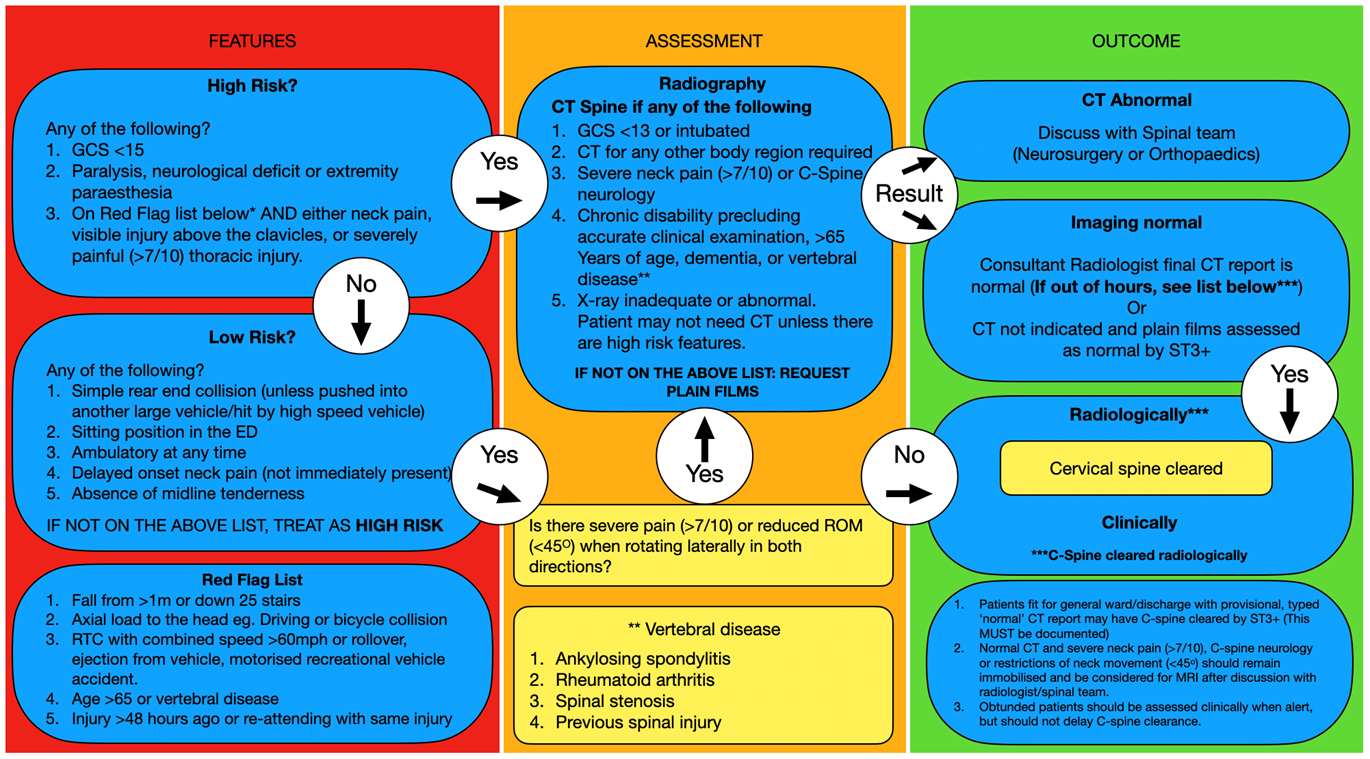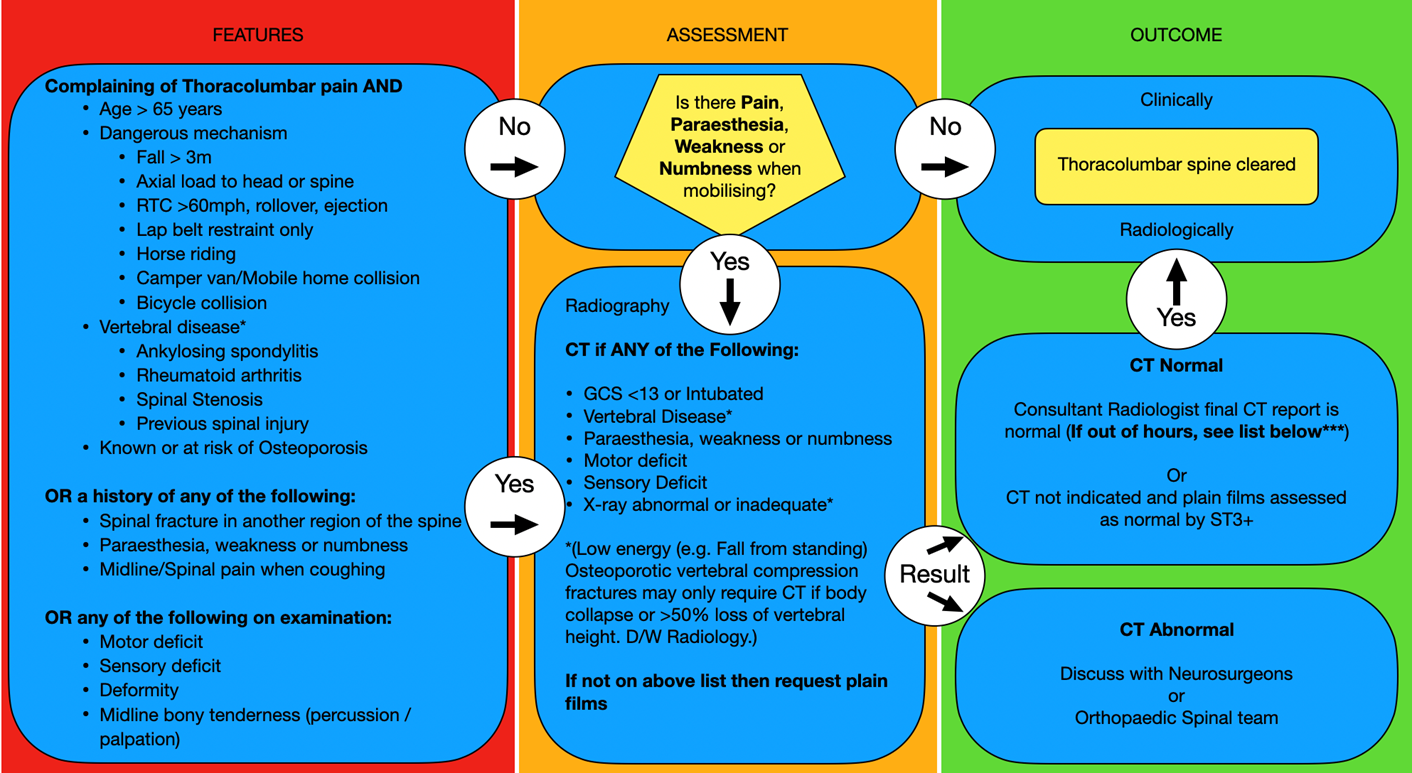Spinal Shock
Total flaccid paralysis of all skeletal muscle and loss of all spinal reflexes below the level of the lesion. It may last several hours to weeks. The return of the bulbospongiosus reflex denotes its end.
Neurogenic Shock
Body's response to sudden loss of sympathetic control in cervical and high thoracic lesions (above T6). Hypotension is from a lack of vasomotor control. Bradycardia from of an unopposed vagus nerve.
Airway
Intubation can precipitate severe bradycardia and cardiac arrest in cervical/high thoracic spinal cord injuries. Atropine 0.3mg / 0.6mg may be required.
Breathing
Patients with high cord lesions (C3/4/5) have a considerable risk of respiratory deterioration.
- Monitor SaO2, blood gases and vital capacity
- Use humidified oxygen
- Early, regular, and frequent physiotherapy including assisted cough and incentive spirometry
- Hourly turns to optimise V/Q mismatch
- Elective ventilation may be needed
- Secure airway if vital capacity <1L
- Consider primary tracheostomy
- Pre-oxygenate with 100% oxygen before and after suctioning as bradycardia and hypoxia can occur.
Circulation
- Patients with acute spinal cord injury must be nursed flat.
- Monitor BP usually via arterial line.
- Maintain SBP >100mmHg. Initial MAP target 85mmHg. Consider maintaining these targets for 7 days.
- Maintain urine output of >30mls per hour.
- Administer IV fluids - DO NOT over-infuse. This may precipitate cardiac failure and pulmonary oedema.
- Vasoconstrictors via a central line may be required to maintain a stable BP.
- Use atropine 0.5-1.0mg or glycopyrrolate 200-600mcg IV for bradycardia <40bpm or instability.
- Bradycardia usually resolves over a few days. Avoid pacemakers where possible.
Disability
- Ensure ASIA chart (Appendix 6) is completed in full
- Perform neurological examinations 2 hourly to identify and prevent any avoidable deterioration.
Other considerations
- Do not give IV steroids
- LMWH (Low Molecular Weight Heparin) VTE prophylaxis should be started by day 3 and TEDs/Flowtrons on admission.
- Give regular PPI
- Prescribe nebulised saline, salbutamol 2.5mg and ipratropium 250mcg 4 hourly in all high cord injuries.
- Monitor for signs of alcohol withdrawal.
Skin
- Heels should be supported clear of the bed with pillows.
- Pressure relief and minimum 30 degrees side to side turning should occur every 2 hours from admission.
Bladder
- All patients should be catheterised.
- If priapism is present, initially manage with urethral catheterisation where possible. May require a suprapubic catheter.
Paralytic ileus
- Nil-by-mouth.
- NG tube in all patients (may precipitate bradycardia).
- If abdomen is distending due to build up of gas, consider PR examination and decompression.
- Commence NG nutrition as soon as feasible.
Bowel
- Daily insertion of a glycerin or bisacodyl suppository 15-30 minutes before rectal examination and evacuation if rectum full.
- If bowel sounds present, passing flatus or moving bowels then start in ALL patients:
- Senna 15mg alternate evenings
- Lactulose 15ml b.d.
- OR if unsuccessful consider Macrogol 1 sachet b.d.
- Bisacodyl 10mg alternate evenings
AND if T12 & above (reflex UMN bowel)
- Daily PR
- Daily anal digital stimulation to trigger reflex. CHECK digitally that emptying is complete
OR if L1 or below (flaccid LMN Bowel)
- daily PR
- daily manual evacuation of faeces (essential in these patients).
The use of a FLEXISEAL faecal collection device should take into consideration the risks and benefits to that patient. (E.g., Preservation of sacral skin integrity vs daily assessment of anal tone.)
Analgesia
- Prescribe simple analgesia e.g., paracetamol
- Opiates for fractures but caution in high cord injuries
- Neuropathic analgesics e.g., gabapentin/amitriptyline.
Joint mobility
Daily passive limb movement, stretching and positioning with input from PT, OT and nurses from admission.
Other guidance
Further guidance on mobilisation, autonomic dysreflexia, weaning and other issues is available at www.spinalunit.scot.nhs.uk and www.spinalcordinjury.nhs.uk.
Contact Edenhall for nursing advice on 0141 201 2533
NICE Guidelines for Spinal Injury Assessment and Initial Management are available (click here)



